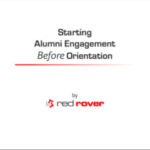The following is the fourth draft slice of an upcoming curriculum supplement I am writing for Bedford / St. Martin’s press.
Here are parts 1**, 2**, and 3**.
Your comments and critique, as always, are appreciated.
Comfort
Comfort is curing the loneliness that inevitably comes with moving to a new peer network. Some evidence suggests that the brain may even process social exclusion using the same circuitry as physical pain. Loneliness hurts.
I grew up in Minnesota and went to college at the University of Oregon. In high school I had an incredible group of friends. I was never cool per se, but I felt appreciated, influential, and comfortable.
My first year at the University of Oregon was a social mess. I was lonely and often depressed.
In hindsight, it’s clear that my sense of personal worth was embedded in my social network. The network I left behind. I went off to college and left my confidence at home.
My roots were deep in Minnesota – 18 years with pretty much the same group. The creation of my group while growing up was unconscious and slow; it was identity development in a crock pot. (For those not from the Midwest, that’s slow marination in low heat.)
It took me a few years to find my friends at Oregon, re-grow some roots, and reestablish my sense of belonging.
Those first few years were not very “educational” in the sense of engagement with my classes or academic ideas. Being lonely colored everything in gray. Belonging comes before confidence, aspiration, or problem solving and learning on Maslow’s Hierarchy and this is reflected in my transcript. Big lecture halls just made me feel more alone – people all around me, but very few connections.
I had it better than many. My family was strong and supportive (if far away). I had models of college success nearby. It was still a very hard time.
Being in a strange new place surrounded by new people is disorientating. What has changed is that the tools to stay in touch with the old network have become much, much, better. When I went to college in the early 1990’s, I largely left my network behind. I had no cell phone to keep me in contact with old friends and parents. I had to plan a scheduled time to call home, or rely on written letters that came few and far between.
Cellphones, instant messaging, Skype and Facebook, as connective technologies, all serve to keep the new student connected to their old network of family and friends. In 2008, a poll published by the Pew Internet and American Life Project found that technology enables connections “that revolve around remote cell phone interactions and communal internet experiences.”
Some see improved connectivity to home as a concern. The concern is that students will come to be addicted to their online relationships in their old network at the expense of new, real world relationships. The other common concern is that connected parents let students feel coddled, preventing them from growing up, and destroying their ability to make new contacts and become an independent person.
Embedded in both of these concerns is a preference for discomfort as catalyst for growth. The worry is that comfort – either through online relationships or frequent conversations with parents – will actively prevent growth.
A core tenet of John Gardner’s First Year Experience movement is to move higher education past this “college as boot camp” mentality. The goal is not to make students suffer, weeding out the weak. The goal is to make them successful. More swimming lessons, less throwing them into the deep end. To abuse the metaphor, if Facebook and “Helicopter parents” serve as “social floaties” for those that need them, all the better, as long as they don’t get stuck with them.
Switching networks, from old to new, is important for growth. Getting emotionally and mentally stuck in the old network does not help the student succeed. Cutting them off from the home network entirely is not the answer. It’s also not possible.
Much like the media perpetuating fear around the internet, higher education loves to share ghost stories about helicopter parents. Did you hear the one about the student that brought their parent to a job interview? While surely some parents go overboard, the name calling and stereotyping unfairly impugns the actions of the vast majority of parents who are simply being helpful. In an era of ruthless budget cuts, higher education can use all the help it can get from a student’s supportive home network.
The benefit of a supportive network is highlighted by the stories and statistics of its absence. First generation college students are more likely to be an anomaly among their home peer networks. For them, there is an acute need to connect to the new network and new peer norms.
Carlito Umali gave his commencement speech at his college. I found him because he was profiled in an article in the Seattle Post Intelligencer. Carlito is notable because he is a first generation college student who succeeded against the odds. More than half of first-generation college students who enroll in a four year college will not graduate.
What does he think is the most important aspect of his success?
“Community, I believe, is really the foundation of all education no matter what you’re studying,” the English major said. “In one way or another, you’re trying to find community.”
If the student is lucky enough to have a supportive network, this early, now transportable, sense of emotional security and belonging is actually a great place to start. It’s a terrific foundation on which they can build new connections to their new place, without having to endure the rootlessness that I felt.
These tools – cell phones, the internet in general and Facebook in particular – are great for staying in touch with the old network, but they are not as good at helping the student find comfort within a new network. They are designed for social capital maintenance, not the social or academic integration that is needed.
Finding Comfort Online:
Even though it’s not designed for it, students do try to use Facebook to find comfort in common attributes among the new people. The nature of the web, and search specifically, changes the game. Online, search replaces small talk. This is especially true in asynchronous environments (anything other than live, synchronous chat). Students naturally start by trying to search and express their identity attributes as a starting point for social comfort.
Most schools will have an incoming first year student group on Facebook, called “Hamline University, class of 2013” or something similar. The wall posts on these groups show students putting up identity flags: “Who’s playing soccer this fall?” “Who else is in Watson Hall fourth floor?”
The problem with the Facebook wall as a place to meet new people is that each question pushes down the question in front of it, so a typical wall has many questions and very few replies. While it’s better than nothing, it’s far from ideal.
Schools get concerned, and occasionally overreact, when the common facet of introduction on the Facebook wall sinks to the lowest common denominator: “Who else can’t wait to party this fall?” These comments come from students who are not shy, but don’t yet have a better conversation starter.
Students want to meet new people to create comfort in their new environment. Many of us find meeting new people in a new environment a bit of a challenge. For many students (or adults), if they can’t find something positive to meet over, they will meet over beer. This can be an especially challenging dynamic for schools that serve as a “13th grade” – a second choice culture, where students end up there precisely because they have not yet found a direction for themselves. These students need the most support in connecting over something that won’t lead to a hangover.
How can you help students find comfort within the First Year Experience?
Label the process. Let students know of the emotional challenges to expect. Help them frame the positive feelings they will get from Facebook and their online interactions with the old network, while at the same time emphasizing the fact that their success will be in finding community feeling and comfort within their new environment. Ask them about their success in using Facebook to find new people – have an open dialogue on the topic – experiences will vary. The students will learn from each other in this discussion and begin to place new goals on old (to them) technology. With the goal of feelings of community in mind, have the students brainstorm tactics for reaching those feelings. When I’ve facilitated these conversations in the past, it does not take long for some students to express the importance of finding possible connections online and then following through to a face to face meeting. This “don’t get stuck online” reminder is best delivered by peers in discussion, rather than by the teacher or facilitator.
Invite student leaders, or other model students from past years, into your class to share their stories of finding an early community and what steps they took. These stories will add meaning to future assignments designed to help with social and academic connection and integration. If you are lucky enough to be in a school where there are blogs (online journals or reflective learning artifacts) from previous students at the same school, provide these to your students – prioritizing blogs of students from similar backgrounds. It is extremely interesting for students to read the thoughts of people like them who have been through the experiences they are currently going through. Second best are blogs from other schools. At the end of this supplement, there will be links to resources online to help you find these blogs.
Bring exercises into class that help students explore their interests through conversation and activities with other classmates or members of the college community. This will begin to grow their expectations of their network – moving past simply social comfort (people to hang out with) and into topic connection (people to learn with).
Work with orientation to expand the identity expression / connection pattern as close the admission process as possible. Studies have shown that a longer orientation time period leads to better retention rates. The more time students have to get socially situated, the more comfortable they become. Refer to the online materials for examples of schools using technology to implement various versions of this.
What to expect from technology in the near future.
Students will continue to share personal information online through Facebook, blogs, Twitter, and photo-sharing sites. Technology will continue to get better at leveraging this information to connect students to others based on shared interests, backgrounds, and goals. Many organizations and private companies are actively working on this challenge. A few schools across the country have already deployed “roommate matching” services that connect students with similar interests or levels of cleanliness. This is a small example of the possibilities.
The narrative of dislocation, loneliness, and finding one’s place is very common and very old. As more students blog, schools will begin to aggregate these narratives, providing an authentic, journal like glimpse into lives of other students. Peer stories, combined with relevancy matching, will serve as a powerful source of comfort.
Engagement through social media (blogs, Twitter, Facebook, etc.) creates huge amounts of live data. New tools will leverage this data to provide live assessments of a variety of online social activity. These behavioral metrics, will, over time, begin to supplant less accurate and less actionable self reported surveys for both focusing staff and faculty time where it is needed and providing feedback and encouragement to the students. Imagine a dashboard display that measures the social connectivity of students based on twitter conversations, Facebook photo tagging, new “friends” on Facebook, school fan page responses, etc. If you as a faculty member could map the social network of your class, and watch it develop over time, you would have a powerful feedback mechanism to help the students that need it. While the statistical models are still emergent, the collection technologies are here today.
The tools will evolve, but the goal will remain the same; Help new students find social comfort. Help them find comfort within the first year experience class and at the school. You are not competing with their home network, you are building on top of it. Creating or leveraging a foundation of social comfort for students reduces their risk of them dropping out and allows them to move to the next level of student success: connection.




